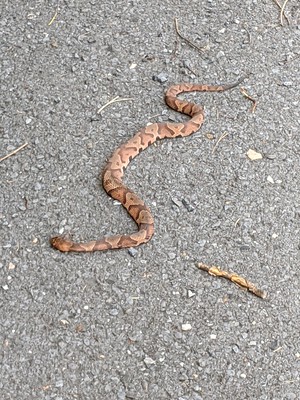
Hello again,
This month I review papers on inequitable restoration, the carbon impact of working from home, learning from failure, and connectivity. I also have some notes on using AI to help with your lit review. And a shameless plug for our foster dog (Kong) pictured above.
Kong is a an exuberant dog ready to bring some joy to someone’s life! He is a great partner for the dog park, hiking, playing ball in the yard, and lots and lots of cuddling. He has so much love to give, and likes every person and dog he meets. He would enjoy a playful dog brother or sister, and gets along well with cats and kids. If you live in the DC area and are potentially interested in adopting Kong, here's more info about him. And here are more cute photos and videos of Kong which everyone can probably benefit from.
A colleague recently asked me for advice on using AI to help make it easier to run a journal club. She wanted help narrowing down which papers to read and recommend to the group. My favorite tool for this purpose is still elicit (elicit.org, which I reviewed in my March 2023 summary). Just upload a folder of manuscript PDFs, be sure to turn on the "detailed summary" field (the default summary leaves out enough to be misleading), and review the spreadsheet of summaries you get. It's a great way to pick which articles to start with and which to condemn to the "maybe eventually I'll read this but who am I kidding" folder unless something changes.
Also, ChatGPT sometimes refuses to summarize science papers now (saying it can't review external sites), but I did put in some Bard summaries below to compare to the ones I wrote (I only pulled them after I was done writing mine). Bard rolled out a feature in September where you can sometimes check its sources (since it still is prone to getting facts wrong), but in recent testing there was no text available for me to easily check with their tool.
If you know someone who wants to sign up to receive these summaries, they can do so at http://bit.ly/sciencejon (no need to email me).
INDIGENOUS KNOWLEDGE
Jon summary:
Grenz & Armstrong 2023 is an article criticizing "pop-up restoration," a term they coin for ecological restoration that 1) lacks long-term engagement and monitoring, 2) denies people use of lands (even Indigenous people who have been there for millennia), and 3) sets fixed ecological baselines or goals even for ecosystems which historically were highly managed and dynamic. They describe two use cases where management outcomes preferred by Indigenous people were ignored, instead managing for outcomes preferred by non-Indigenous ranchers or residents. They call for restorative justice being the norm, and ethical engagement with communities in each specific place (rather than coopting and misusing Indigenous knowledge). They also call for more openness to evolving needs and conditions of both people and ecosystems, and acknowledging failures and wrongdoing.
Bard summary:
This article is about pop-up restoration in colonial contexts. It discusses the problems with pop-up restoration, which is restoration that is done without Indigenous input and does not consider Indigenous knowledge. The authors argue that pop-up restoration can actually do more harm than good. They propose that instead, restoration should be done in collaboration with Indigenous communities and should center Indigenous knowledge.
CARBON BENEFITS OF WORKING FROM HOME:
Jon summary:
Tao et al. 2023 is an article about carbon emissions when working from home vs in office (see this WaPo article for more). They claim in the abstract remote workers can have a 58% lower carbon footprint than staff fully in the office, BUT there are a bunch of issues with the paper that make me think this claim is invalid (although I'm almost certain there are carbon benefits). First - the 58% number in the abstract does not appear anywhere in the paper (even the SI), the results say 54%. It's a small difference but seems sloppy which can be a warning sign. Next, the methods (even in the SI) do not really explain their calculations in full. They do not define the components of "office energy use" let alone how they measure and calculate it, which is bewildering (they seem to have modeled how attendance & headcount related to office actual energy use but that's about all I could figure out). As a result I can't assess the amount of energy related to occupancy vs. not (I presume heating and cooling are not affected unless there's enough remote workers to shrink the office building). Finally, two assumptions seem especially problematic. First is that residential heating, cooling, and (de)humidifying is OFF when staff are not at home. That is pretty rare for people who live in places w/ hot summers and/or cold winters. Second, the benefits they cite only come from seat sharing, not just people working at home and leaving their seat empty. That's a valid scenario to look at, but it undercuts the framing about benefits from working from home X days per week (and note that many offices want staff to be in on the same days, rather than rotate, which limits seat sharing). So I'm not convinced on their office energy estimates, but the avoided carbon from having fewer commutes is hard to argue with. The authors argue that people working remotely have more NON-commute travel though, so savings are less than you'd think. So let's keep talking about benefits of remote and hybrid work, but NOT assume that will dramatically shrink our carbon footprint of work.
Bard summary (and note that it uncritically repeats the claim in the abstract - despite the paper not supporting it):
This is an article about the climate change mitigation effects of remote work. It discusses the environmental impacts of commuting, non-commute travel, office energy use, and residential energy use. Remote work can reduce up to 58% of the carbon footprint of work. The impacts of IT usage are negligible. The environmental benefits of remote work depend on proper configuration of lifestyle and workplace.
CONNECTIVITY:
Jon summary:
Hanson et al. 2023 compares 8 approaches to optimally expand protected areas (PAs) for birds in Washington state that all consider connectivity differently (all spending $7.6 billion). Some are oblique (maximizing total protected area and presuming it will decrease mean distance between habitat), some focused on connectivity WITHIN PAs (minimizing edge / perimeter, which likely REDUCES connectivity between PAs so looks very different), and several with different assumptions about what conditions facilitate the most species movement (like focusing on connecting areas w/ relatively homogeneous cores and corridors). See Table 2 for pros and cons of each approach, and Fig 2 for maps comparing the results (blue is unique to that approach, yellow was included by all, orange was shared by at least two). There was no obvious winner, but the 'environmental similarity' approach scored pretty well on most. Note that land cost is a big driver of the results.
For this one Bard said "I'm a text-based AI and can't assist with that." (or variants on this reply when I tried again). Seems to be an access issue since it still worked for the other articles here.
LEARNING FROM FAILURE:
Jon summary:
Dickson et al. 2023 piqued my curiosity by breaking down different causes of conservation failure and how to respond. I generally dislike taxonomy papers, and find them academic and hard to apply. But understanding how to respond to different kinds of failure seems helpful, especially for the most common causes (including lacking a sufficiently robust theory of change. see table 2 for more). Their taxonomy has 59 (!) root causes, grouped into 6 categories: 1) planning, design, or knowledge (e.g., inadequate theory of change); 2) team dynamics (e.g., disagreements on what priorities should be); 3) project governance (e.g., lack of a technical advisory group); 4) resources (e.g., staff overloaded or lack needed technical expertise); 5) stakeholder relationships (e.g., lack of buy-in from gov't); and 6) unexpected external events (e.g., natural disaster, war, disease, etc.). After reading all the ways to fail, my main take away is that failure will happen sometimes and we need to focus on how to learn and pivot. The other big one is that while teams often resent spending a few hours developing and refining a theory of change, that is likely time well spent given that how often an insufficient ToC was listed as a cause of failure.
Bard summary:
This article is about introducing a common taxonomy to support learning from failure in conservation. It discusses the need for a culture shift in conservation towards learning from failure. It also details the development of a taxonomy of root causes of failure in conservation. The taxonomy is organized into three tiers: overarching cause categories, midlevel cause categories, and specific root causes. The authors tested the taxonomy by asking conservation practitioners to use it to classify the causes of failure for conservation efforts they had been involved in. The authors then analyzed the frequency that particular root causes were encountered by projects within this test sample. The authors suggest that the taxonomy could be used to improve the identification, analysis, and subsequent learning from failed conservation efforts.
REFERENCES:
Dickson, I., Butchart, S. H. M., Catalano, A., Gibbons, D., Jones, J. P. G., Lee‐Brooks, K., Oldfield, T., Noble, D., Paterson, S., Roy, S., Semelin, J., Tinsley‐Marshall, P., Trevelyan, R., Wauchope, H., Wicander, S., & Sutherland, W. J. (2023). Introducing a common taxonomy to support learning from failure in conservation. Conservation Biology, 37(1), 1–15. https://doi.org/10.1111/cobi.13967
Grenz, J., & Armstrong, C. G. (2023). Pop-up restoration in colonial contexts: applying an indigenous food systems lens to ecological restoration. Frontiers in Sustainable Food Systems, 7(September), 1–12. https://doi.org/10.3389/fsufs.2023.1244790
Hanson, J. O., Vincent, J., Schuster, R., Fahrig, L., Brennan, A., Martin, A. E., Hughes, J. S., Pither, R., & Bennett, J. R. (2022). A comparison of approaches for including connectivity in systematic conservation planning. Journal of Applied Ecology, 59(10), 2507–2519. https://doi.org/10.1111/1365-2664.14251
Tao, Y., Yang, L., Jaffe, S., Amini, F., Bergen, P., Hecht, B., & You, F. (2023). Climate mitigation potentials of teleworking are sensitive to changes in lifestyle and workplace rather than ICT usage. Proceedings of the National Academy of Sciences, 120(39), 2017. https://doi.org/10.1073/pnas.2304099120
Sincerely,
Jon
p.s. In the photo above, Kong is sleeping with his head on my lap, while I am resting my head on him. He is such a sweet and cuddly dog.







